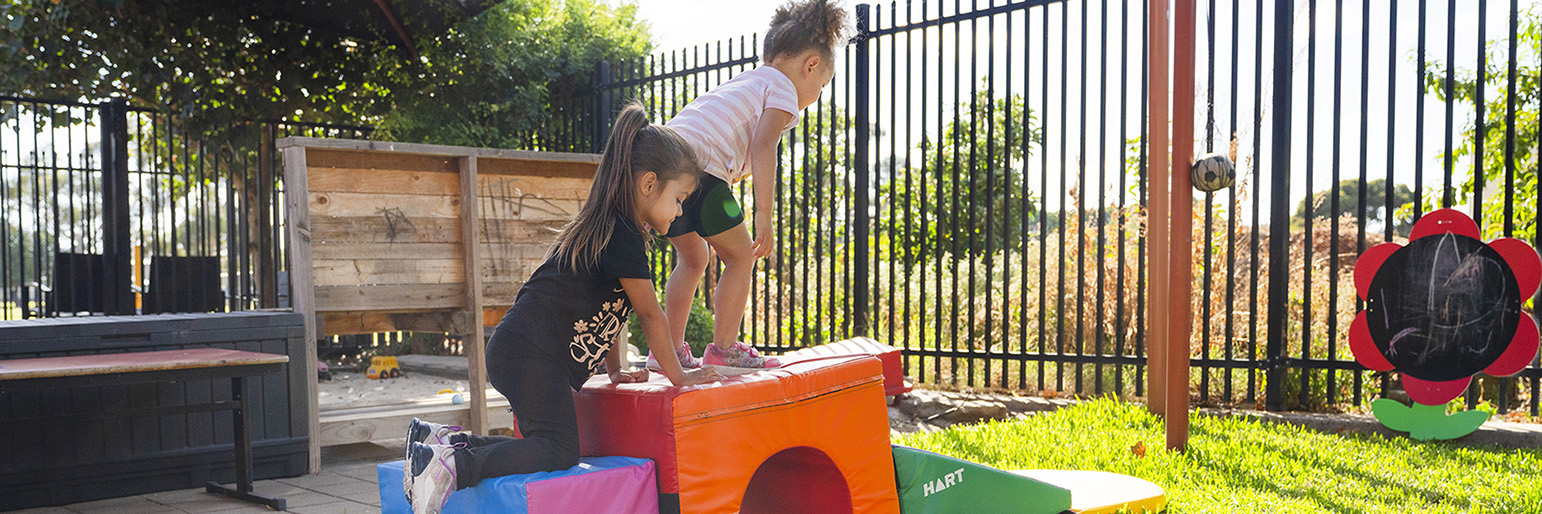Obstacle course
Playing together
You can make an obstacle course using everyday items. This is a great way for children to develop sensory and motor skills in a fun and interactive way, as well as encouraging active play.

Activity
You can make an obstacle course with children inside or outside. Try and build different challenges that each child can walk on, up, over, under or through.
What you'll need
- Cushions
- Tunnel (or a table and blanket)
- Hoops
- Wooden plank
- Masking tape
- Roll mats
- Stepping stones (can use old telephone books wrapped in paper)
- Large boxes
- Bean bags
- Plastic cones (could use milk or soft drink bottles filled with water)
- Broomstick through milk containers makes a great hurdle
Words to use
- Up/down, over/under, through/around
- Climb, jump, crawl, balance
- Start/finish
- Tape, cushion
- Fast/slow, careful
- Obstacle, course
Questions to discuss
- Which part do you like the best?
- Is that tricky for you? That’s okay, just try again.
- What else can we add to the course?
Learning through play
Ways to develop numeracy through play
- Talk about positions. Over/under and through – this is teaching them about space.
- What about climbing over or under? You could use a large cardboard box for a tunnel, or a pile of cushions that can be scaled like a mountain.
- You could use plastic cones or a line of toys for your child to weave through.
- Can you go fast/slow? Use a stopwatch to time each child (speed/time).
- How many times can you do the obstacle course? Keep a tally or give a stamp on the child’s hand for each lap completed.
- Make a graph of how many laps each child does.
- Include stations such as, ‘jump 3 times like a kangaroo’ – you could count as they jump.
Ways to develop literacy through play
- Problem-solving is an important skill that helps children in everyday life and in education settings. It helps them to look at alternatives and think about possibilities.
- Make obstacles that children can:
- balance on, like a flat piece of wood or a masking tape line.
- crawl over or under, like cushions or a table.
- reach and stretch, like hanging balloons or a soft ball in a stocking. Children can try and hit them with a bat.
- Gross, or big, muscle development helps children to build their strength, become more active and will later help with being able to write effectively in the development of fine motor skills.
- Make signs of instructions for children to follow. Remember to use pictures as well as words.
- Read We’re Going on a Bear Hunt by Michael Rosen and Helen Oxenbury.
Extensions and variations to this activity
- Go on a ‘bear hunt’.
- Make an obstacle course at a playground using the equipment.
- Balance with bean bags on your head and other body parts.
- Sing Five Grey Elephants Balancing.
- Have mini-Olympics or sports day.
- Bean bag toss.
Supporting parent engagement in play
Parents or carers can:
- Comment on what their children are doing (say what they see).
- Talk in their home language.
- Use literacy and numeracy words (see words to use section above).
- Stay with their child and encourage them to ‘have a go’.
- Support their child where they need help.
- Count how many laps their child completes.
- Time their child with a watch or just count how long they take to get around the course.
You can help families by:
- Modelling what you want them to do.
- Talking to them about the focus of the activity and what children might be learning.
- Writing up words that go with the activity.
- Making suggestions on what families can do at home.
Related Great Start activities
Great Start activities are for parents and carers to do with their children.


